AMD Zen 3 Ryzen Deep Dive Review: 5950X, 5900X, 5800X and 5600X Tested
by Dr. Ian Cutress on November 5, 2020 9:01 AM ESTCPU Tests: Encoding
One of the interesting elements on modern processors is encoding performance. This covers two main areas: encryption/decryption for secure data transfer, and video transcoding from one video format to another.
In the encrypt/decrypt scenario, how data is transferred and by what mechanism is pertinent to on-the-fly encryption of sensitive data - a process by which more modern devices are leaning to for software security.
Video transcoding as a tool to adjust the quality, file size and resolution of a video file has boomed in recent years, such as providing the optimum video for devices before consumption, or for game streamers who are wanting to upload the output from their video camera in real-time. As we move into live 3D video, this task will only get more strenuous, and it turns out that the performance of certain algorithms is a function of the input/output of the content.
HandBrake 1.32: Link
Video transcoding (both encode and decode) is a hot topic in performance metrics as more and more content is being created. First consideration is the standard in which the video is encoded, which can be lossless or lossy, trade performance for file-size, trade quality for file-size, or all of the above can increase encoding rates to help accelerate decoding rates. Alongside Google's favorite codecs, VP9 and AV1, there are others that are prominent: H264, the older codec, is practically everywhere and is designed to be optimized for 1080p video, and HEVC (or H.265) that is aimed to provide the same quality as H264 but at a lower file-size (or better quality for the same size). HEVC is important as 4K is streamed over the air, meaning less bits need to be transferred for the same quality content. There are other codecs coming to market designed for specific use cases all the time.
Handbrake is a favored tool for transcoding, with the later versions using copious amounts of newer APIs to take advantage of co-processors, like GPUs. It is available on Windows via an interface or can be accessed through the command-line, with the latter making our testing easier, with a redirection operator for the console output.
We take the compiled version of this 16-minute YouTube video about Russian CPUs at 1080p30 h264 and convert into three different files: (1) 480p30 ‘Discord’, (2) 720p30 ‘YouTube’, and (3) 4K60 HEVC.
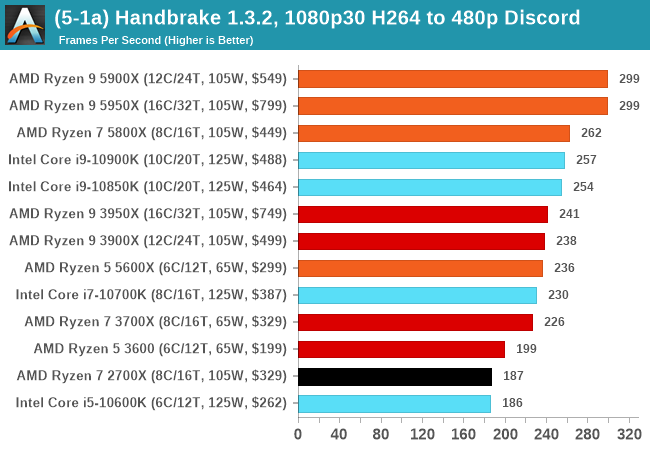
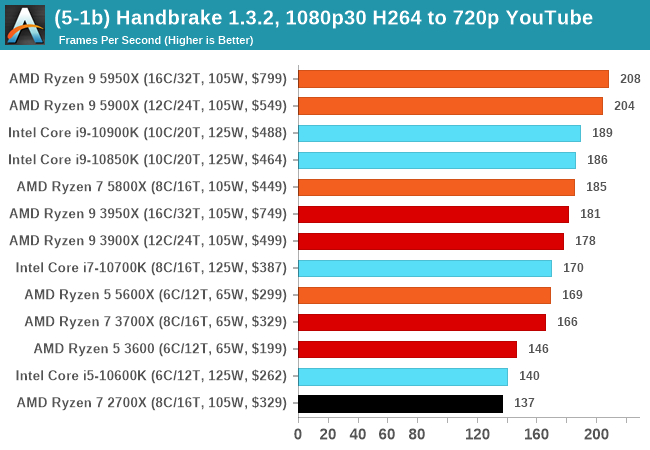
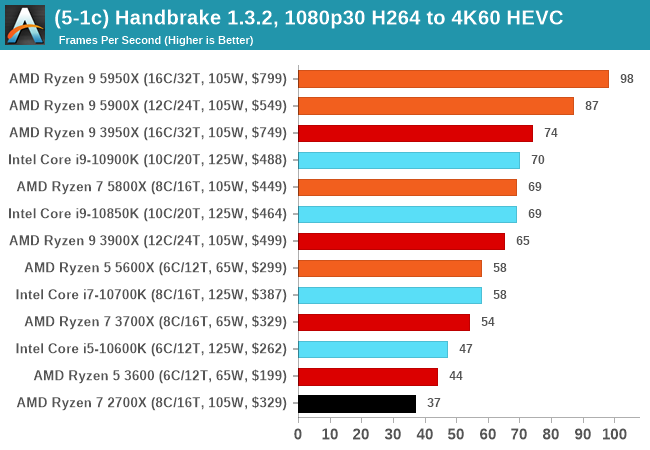
7-Zip 1900: Link
The first compression benchmark tool we use is the open-source 7-zip, which typically offers good scaling across multiple cores. 7-zip is the compression tool most cited by readers as one they would rather see benchmarks on, and the program includes a built-in benchmark tool for both compression and decompression.
The tool can either be run from inside the software or through the command line. We take the latter route as it is easier to automate, obtain results, and put through our process. The command line flags available offer an option for repeated runs, and the output provides the average automatically through the console. We direct this output into a text file and regex the required values for compression, decompression, and a combined score.

AES Encoding
Algorithms using AES coding have spread far and wide as a ubiquitous tool for encryption. Again, this is another CPU limited test, and modern CPUs have special AES pathways to accelerate their performance. We often see scaling in both frequency and cores with this benchmark. We use the latest version of TrueCrypt and run its benchmark mode over 1GB of in-DRAM data. Results shown are the GB/s average of encryption and decryption.
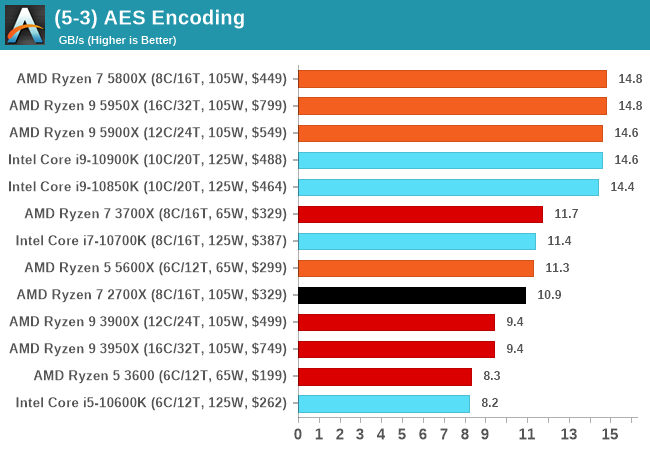
WinRAR 5.90: Link
For the 2020 test suite, we move to the latest version of WinRAR in our compression test. WinRAR in some quarters is more user friendly that 7-Zip, hence its inclusion. Rather than use a benchmark mode as we did with 7-Zip, here we take a set of files representative of a generic stack
- 33 video files , each 30 seconds, in 1.37 GB,
- 2834 smaller website files in 370 folders in 150 MB,
- 100 Beat Saber music tracks and input files, for 451 MB
This is a mixture of compressible and incompressible formats. The results shown are the time taken to encode the file. Due to DRAM caching, we run the test for 20 minutes times and take the average of the last five runs when the benchmark is in a steady state.
For automation, we use AHK’s internal timing tools from initiating the workload until the window closes signifying the end. This means the results are contained within AHK, with an average of the last 5 results being easy enough to calculate.
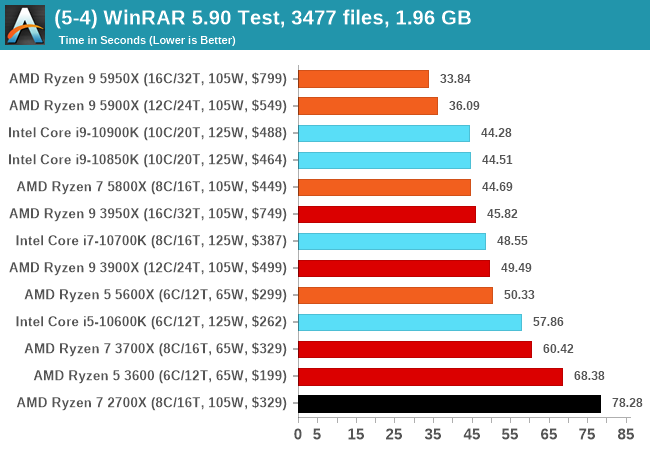


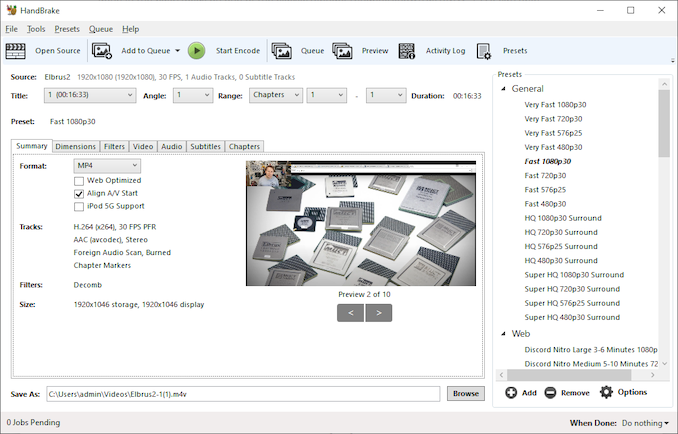
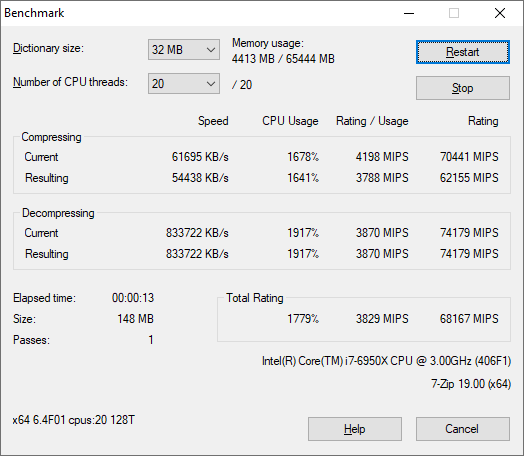
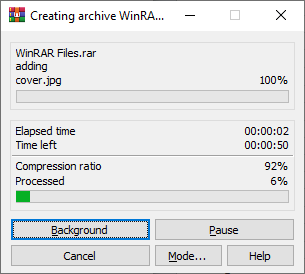








339 Comments
View All Comments
TheinsanegamerN - Tuesday, November 10, 2020 - link
There is no x590 chipset coming. X570 is ryzen 5000s chipset.There's also this miracle fo technology, if you have a micro atx or full atx board, you can put in ADD IN CARDS. Amazing, right? So even if your board does not natively support 2.5G LAN you can add it for a low price, because 2.5G cards are relatively cheap.
TheinsanegamerN - Tuesday, November 10, 2020 - link
the x570 aorus master and msi x570 unify also have 2.5G lan. And surely there will be newer models next year with newer features and names, gotta keep the model churn going!alhopper - Sunday, November 8, 2020 - link
Ian and Andrei - 1,000 Thank Yous for this awesome article and you fine technical journalism. You guys did amazing work and we (the community) are fortunate to be the benefactors.Thanks again and keep up the Good Work (TM).
Rekaputra - Sunday, November 8, 2020 - link
Wow this article it so comprehensive. Glad i always check anandtech for my reference in computing. I wonder how it stack againt threadripper on database or excel compute workload. I know these are desktop proc. But there is possibility use it for mini workstation for office stuff like accounting and development RDBMS as it is cheaper.SkyBill40 - Sunday, November 8, 2020 - link
Once some availability comes back into play... my old and trusty FX 8350 is going to be retired. I've been waiting to rebuild for a long time now and the wait has clearly paid off regardless of how the is the end of the line for AM4 or well Ryzen 4 does next year. I could wait... but nah.jcromano - Friday, November 13, 2020 - link
I'm in a similar boat. I'm still running an i5-2500k from early 2011 (coming up on ten years, yikes), and I'll build a new rig, probably 5600X, when the processors become available. I fret a bit over whether I should wait for the next socket to arrive before taking the plunge, but given the infrequency with which I upgrade, I think it's likely that the next socket would also be obsolete by the time it mattered.evilpaul666 - Sunday, November 8, 2020 - link
I'd love to see some PS3 emulation testing added.abufrejoval - Monday, November 9, 2020 - link
Control flow integrity (or enforcement) seem to be in, and that was for me a major criterion for getting one (5800X scheduled to arrive tomorrow).But what about SEV or per-VM-encryption? From the hints I see this seems enabled in Intel's Tiger Lake and I guess the hardware would be there on all Zen 3 chiplets, but is AMD going to enable it for "consumer" platforms?
With 8 or more cores around, there is plenty of reasons why people would want to run a couple of VMs on pretty much anything, from a notebook to a home entertainment/control system, even a gaming rig. And some of those VMs we'd rather have secure from phishing and trojans, right?
Keeping this an EPIC-only or Pro-only feature would be a real mistake IMHO.
BTW ordered ECC DDR4-3200 to go with it, because this box will run 24x7 and pushes a Xeon E3-1276 v3 into cold backup.
lmcd - Monday, November 9, 2020 - link
Starting to feel like the platform is way too constrained just for the sake of all 6 APUs AMD has released (all with mediocre graphics and most with mediocre CPUs, no less). I hope AMD bifuricates and comes up with an in-between platform that supports ~32-40 CPU PCIe lanes and drops APUs. If APUs can't be on-time with everything else there's so little point.29a - Monday, November 9, 2020 - link
"Firstly, because we need an AI benchmark, and a bad one is still better than not having one at all."Can't say I agree with that.